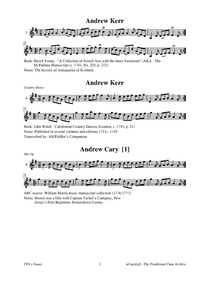Template:Pagina principale/Vetrina: Difference between revisions
No edit summary |
No edit summary |
||
| Line 1: | Line 1: | ||
{{SheetMusic | {{SheetMusic | ||
|f_track= | |f_track=Andrew Carr.mp3 | ||
|f_pdf= | |f_pdf=Andrew Carr.pdf | ||
|f_artwork= | |f_artwork=Clan_member_crest_badge_-_Clan_Kerr.svg | ||
|f_tune_name= | |f_tune_name=Andrew Carey | ||
|f_track_title= | |f_track_title=Andrew Carey | ||
|f_section=abc | |f_section=abc | ||
|f_played_by= | |f_played_by=Abby Newton | ||
|f_notes= | |f_notes= Kerr Crest & Coats of Arms. | ||
|f_caption= | |f_caption=The titles naming Andrew as a 'Kerr' predate the 'Carey' titles (although Carr and Carey are also names used by the same clan). The Kerrs were a Scottish Middle-March Borders clan-family well-known for their raiding, cattle reiving and feuding. | ||
'' | |f_source=Redwing Music RWMCD 5410, Abby Newton - "Castles, Kirks and Caves" (2001) | ||
|f_source= | |||
|f_pix=420 | |f_pix=420 | ||
|f_picpix=200 | |f_picpix=200 | ||
|f_article=[[ | |f_article=[[Andrew Carey | '''Andrew Carey''']] | ||
"Andrew Carey" and variant titles appears in several British musicians' manuscript collections, including William Vickers (Northumberland, 1770), John Buttery (Lincolnshire British army fifer, very early 19th century), Joseph Crawhall (Northumberland, 1872), the Tiller ms., and Thomas Hammersley (London, 1790). | |||
It is contained in vol. 2 (p. 146) of the large mid-19th century music manuscript collection of County Cork cleric and uilleann piper [[wikipedia:James_Goodman_(musicolgist)]] (probably copied from J.T. Surenne's 1854 collection). | |||
In North America the tune was included by Henry Beck in his commonplace book for the flute (1786), Aaron Thompson (New Jersey, 1777-1782), William Morris (Hunterdon County, New Jersey, 1776-1777), and by Thomas Molyneaux in his flute copybook (Shelburne, Nova Scotia, 1788). | |||
{{break}} | |||
Bruce & Stokoe print lyrics to the tune, beginning: | |||
<blockquote> | |||
''As I went to Newcastle, My journey was not far,''{{break}} | |||
''I met with a sailor lad, His name was Andrew Carr.''{{break}} | |||
''And hey for Andrew, Andrew, Ho for Andrew Carr,''{{break}} | |||
''And hey for Andrew, Andrew, Ho for Andrew Carr.''{{break}} | |||
</blockquote> | |||
}} | }} | ||
Revision as of 15:50, 22 September 2023

Played by: Abby Newton
Source: Redwing Music RWMCD 5410, Abby Newton - "Castles, Kirks and Caves" (2001)
Image: Kerr Crest & Coats of Arms.

"Andrew Carey" and variant titles appears in several British musicians' manuscript collections, including William Vickers (Northumberland, 1770), John Buttery (Lincolnshire British army fifer, very early 19th century), Joseph Crawhall (Northumberland, 1872), the Tiller ms., and Thomas Hammersley (London, 1790).
It is contained in vol. 2 (p. 146) of the large mid-19th century music manuscript collection of County Cork cleric and uilleann piper wikipedia:James_Goodman_(musicolgist) (probably copied from J.T. Surenne's 1854 collection).
In North America the tune was included by Henry Beck in his commonplace book for the flute (1786), Aaron Thompson (New Jersey, 1777-1782), William Morris (Hunterdon County, New Jersey, 1776-1777), and by Thomas Molyneaux in his flute copybook (Shelburne, Nova Scotia, 1788).
Bruce & Stokoe print lyrics to the tune, beginning:
As I went to Newcastle, My journey was not far,
I met with a sailor lad, His name was Andrew Carr.
And hey for Andrew, Andrew, Ho for Andrew Carr,
And hey for Andrew, Andrew, Ho for Andrew Carr.
...more at: Andrew Carey - full Score(s) and Annotations
X:1 T:Andrew Kerr M:9/8 L:1/8 R:Country Dance B:John Walsh - Caledonian Country Dances (London, c. 1745, p. 21) N:Published in several volumes and editions 1731-c. 1745 Z:AK/Fiddler's Companion K:G B2d dBG dBG|d2e efg f2A|B2d def efg|D2G GAB A2G:| |:g2d dBG dBG|g2e eae f2d|gfe dBd def|g2G GAB A2G:|]
